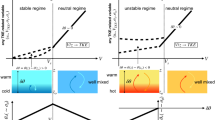Abstract
The integrated momentum and thermodynamic equations through the planetary boundary layer (PBL) are solved numerically to predict the mean changes of wind and potential temperature from which surface fluxes are computed using bulk transfer coefficients of momentum and heat. The second part of the study involves a formulation and testing of a PBL height model based on the turbulent energy budget equation where turbulent fluxes of wind and heat are considered as the source of energy. The model exhibits capability of predicting the PBL height development for both stable and unstable regimes of observed conditions. Results of the model agree favourably with those of Deardorff's (1974a) and Tennekes' (1973) models in convective conditions.
Similar content being viewed by others

References
Alexander, R. C. and Kim, J.-W.: 1976, ‘Diagnostic Model Study of Mixed-Layer Depths in the Summer North Pacific’, J. Phys. Ocean. 6, 293–298.
Ball, F. K.: 1960, ‘Control of Inversion Height by Surface Heating’, Quart. J. Roy. Meteorol. Soc. 86, 483–494.
Blackadar, A. K.: 1957, ‘Boundary Layer Wind Maxima and their Significance for the Growth of Nocturnal Inversions’, Bull. Amer. Meteorol. Soc. 38, 283–290.
Brost, R. A. and Wyngaard, J. C.: 1978, ‘A Model Study of the Stably Stratified Planetary Boundary Layer’, J. Atmos. Sci. 35, 1427–1440.
Businger, J. A., Wyngaard, J. C., Izumi, Y., and Bradley, E. F.: 1971, ‘Flux Profile Relationships in the Atmospheric Surface Layer’, J. Atmos. Sci. 28, 181–189.
Clarke, R. H.: 1970, ‘Recommended Methods for the Treatment of the Boundary Layer in Numerical Models’, Austral. Meteorol. Mag. 18, 51–73.
Clarke, R. H., Dyer, A. J., Brook, R. R., Reid, D. G., and Troup, A. J.: 1971, ‘The Wangare Experiment: Boundary Layer Data’, CSIRO Australia, Division of Meteorological Physics Tech., Paper No. 19.
Carson, D. J.: 1973, ‘The Development of a Dry Inversion-Capped Convectively Unstable Boundary Layer’, Quart. J. Roy. Meteorol. Soc. 99, 450–467.
Carson, D. J. and Smith, F. B.: 1974, ‘Thermodynamic Model for the Development of a Convectively Unstable Boundary Layer’, Adv. Geophys. 18A, Academic Press, New York.
Deardorff, J. W.: 1972, ‘Parameterization of the Planetary Boundary Layer for Use in General Circulation Models’, Mon. Wea. Rev. 100, 93–106.
Deardorff, J. W.: 1974, ‘Three-Dimensional Numerical Study of the Height and Mean Structure of a Heated Planetary Boundary Layer’, Boundary-Layer Meteorol. 7, 81–106.
Denman, K. L.: 1973, ‘A Time-Dependent Model of the Upper Ocean’, J. Phys. Ocean. 3, 173–184.
Kato, H. and Phillips, O. M.: 1969, ‘On the Penetration of a Turbulent Layer into Stratified Fluid’, J. Fluid Mech. 37, 643–655.
Kraus, E. B. and Turner, J. S.: 1967, ‘A One-Dimensional Model of the Seasonal Thermocline: II. The General Theory and its Consequences’, Tellus 19, 98–106.
Kuo, H. L.: 1968, ‘The Thermal Interaction Between the Atmosphere and the Earth and Propagation of Diurnal Temperature Waves’, J. Atmos. Sci. 25, 682–706.
Mahrt, L. and Lenschow, D. H.: 1976, ‘Growth Dynamics of the Convectively Mixed Layer’, J. Atmos. Sci. 33, 41–51.
Smeda, M.: 1979, ‘Incorporation of Planetary Boundary Layer Processes into Numerical Forecasting Models’, Boundary-Layer Meteorol. 16, 115–129.
Smeda, M. and Wilmot, W.: 1978, ‘A Mixed Layer Model of Wind and Density Driven Mixing During a Phytoplankton Bloom’, Univ. of Stockholm, Inst. of Meteorol., Report DM-24.
Tennekes, H.: 1973, ‘A model for, the Dynamics of the Inversion Above a Convective Boundary Layer’, J. Atmos. Sci. 30, 558–567.
Tennekes, H.: 1975, ‘Reply to Zilintinkevich, 1975’, J. Atmos. Sci. 32, 992–995.
Tsann-Wang-Yu.: 1978, ‘Determining Height of the Nocturnal Boundary Layer’, J. Appl. Meteorol. 17, 28–33.
Venkatram, A.: 1977, ‘A Model of Internal Boundary-Layer Development’, Boundary-Layer Meteorol. 11, 419–437.
Wood, J. W.: 1969, ‘On Richardson's Number as a Criterion for Laminar-Turbulent-Laminar Transition in the Ocean and Atmosphere’, Radio Sci. 4, 1289–1298.
Yamamoto, G., Shimanuki, A., Aida, M., and Yasuda, N.: 1973, ‘Diurnal Variation of Wind and Temperature Fields in the Ekman Layer’, J. Meteorol. Soc. Japan 51, 6, 378–387.
Zilitinkevich, S. S.: 1975, ‘Comments on a ‘A Model for the Dynamics of the Inversion Above a Convective Boundary Layer’’, J. Atmos. Sci. 32, 991–992.
Author information
Authors and Affiliations
Additional information
Contribution number 396.
Rights and permissions
About this article
Cite this article
Smeda, M.S. A bulk model for the atmospheric planetary boundary layer. Boundary-Layer Meteorol 17, 411–427 (1979). https://doi.org/10.1007/BF00118608
Received:
Issue Date:
DOI: https://doi.org/10.1007/BF00118608



